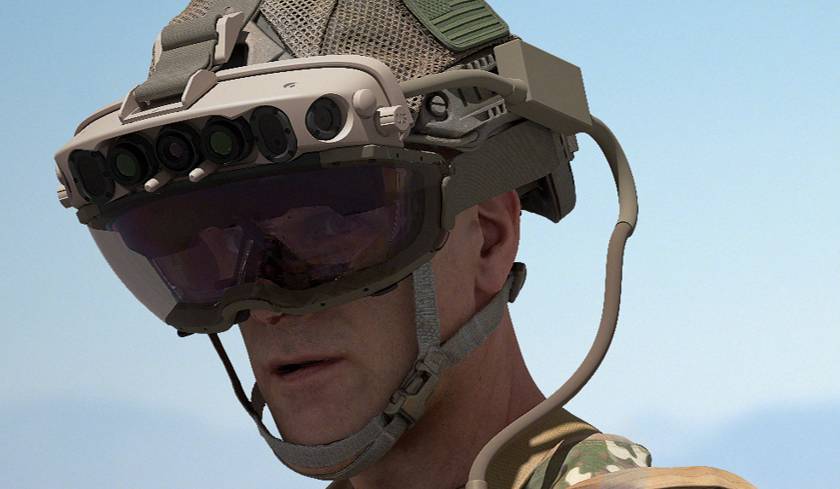DARPA Worried Battlefield Mixed Reality Vulnerable To 'cognitive Attacks'

DARPA is launching a program to head off "cognitive attacks" for mixed reality headsets that could, in theory, cripple future warfighters when deployed.
The forthcoming Intrinsic Cognitive Security (ICS) program was sent out to tender this week, along with a proposers' day on October 20. On that day, DARPA officials will let bidders know what exactly they want from an ICS system that protects against attacks targeting soldier senses.
Per DARPA's notice, cognitive attacks are defined as any adversarial action that "exploits the intimate connection between users and MR equipment." Such attacks have much in common with typical cyberattacks, like information flooding to force latency, the injection of virtual data, or disruptions of personal area networks.
Cognitive attacks go beyond just disrupting MR headsets and can also include actions like planting real-world objects to overwhelm displays, using physical objects to cause false alarms, and using eye trackers to assess what a wearer is doing. The end result, ultimately, is a soldier with a headset that's either sending them bad info or a piece of hardware that has become so laggy that it makes them nauseous and unable to function.
"The core technical hypothesis of the program is that formal methods can be extended with cognitive guarantees and models to protect mixed reality users from cognitive attacks," DARPA said in its tender announcement.
Formal methods "are rigorous, mathematics-based approaches to provide guarantees about computer-based systems," according to DARPA. To extend that further, NASA notes that formal methods "provide a means to symbolically examine the entire state space of a digital design (whether hardware or software) and establish a correctness or safety property that is true for all possible inputs."
In other words, DARPA wants to mathematically represent cognitive models of "human perception, action, memory and reasoning" and figure out how to build some form of universal protection against cognitive attacks.
"The ICS program will extend formal methods by explicitly creating and analyzing cognitive and other models as part of MR system development to protect the warfighter from adversary attacks," the research agency said.
"Formal methods have not been widely used before to protect MR users, but the cognitive engineering field provides principles upon which models and guarantees can be formulated," a DARPA spokesperson told The Register.
Who needs attackers for mixed reality nausea?
DARPA's ICS cart is moving a bit faster than the Microsoft-derived horse it's tied to, with the US Army's 2022 tests of mixed reality HoloLens headsets finding that it took mere hours of wear for soldiers to report headaches, eyestrain and nausea from the devices.
The Army has worked with Microsoft since 2021 to develop the Integrated Visual Augmentation System (IVAS) out of custom HoloLens hardware, but so far the project hasn't gone that well.
Tests in 2021 were delayed due to technical concerns, and an audit by the DoD's Inspector General last year expressed concern that the whole thing would be a waste of nearly $22 billion because the Army didn't bother to define minimal user acceptance thresholds for fielding of the device.
In January of this year, Congress killed funding for all but development of better IVAS headsets; the Army had asked for $400 million to buy another 6,900 of them, but representatives decided that it only got $40m, and all that had to go toward developing IVAS version 1.2.
- Microsoft's mixed reality dream meets harsh reality of job cuts
- US Army may be about to 'waste' up to $22b on Microsoft HoloLens
- How to shave years off the journey from military lab to real-world use
- Here's what the US Army picked for soldier-worn tactical USB hubs
According to the Army Times, prototypes of IVAS 1.2 were delivered to soldiers for testing in August, and by early September the Army approved further development of the new headsets to make them more affordable and mass-producible, and to integrate the headsets with the military's tactical cloud systems.
Given it is still early days for DARPA's ICS program, soldiers testing IVAS and other mixed reality devices won't be able to rely on cognitive security features anytime soon. We asked DARPA when such technology could make it beyond the lab, and while it unsurprisingly wasn't able to provide a date, the agency seems confident it'll be able to get ICS work done before mixed reality sees widespread battlefield use.
"Methods for developing protected MR systems will be developed by the ICS program before MR systems lacking protections are pervasive and essential," we're told. ®
The Power Of AI: Microsoft's Cloud Sales Reach New Heights
In the ever-evolving landscape of technology, Microsoft has emerged as a frontrunner, leveraging the transformative powe... Read more
Uncovering The Tactics: How Hackers Exploit Developing Countries In Ransomware Testing
In recent years, there has been a concerning rise in hackers using developing countries as testing grounds for ransomwar... Read more
From Silicon Valley To Down Under: Musk's Defense Of Public Interest In The Digital Era
In recent headlines, tech titan Elon Musk has once again captured global attention, this time for his intervention in an... Read more
The Global Semiconductor Landscape: Navigating Through Market Shifts Post Samsung's Earnings Triumph
In the first quarter of 2024, Samsung Electronics announced a staggering 931% surge in operating profits, reaching 6.6 t... Read more
The Balancing Act: Google's Paywalled AI And The Quest For Digital Equity
In an era where artificial intelligence (AI) is no longer the stuff of science fiction but a daily utility, Google's lat... Read more
The Meteoric Rise Of Anthropic: Valuation And The Future Of AI
In an era where artificial intelligence (AI) is not just a buzzword but a cornerstone of technological advancement, Amaz... Read more

